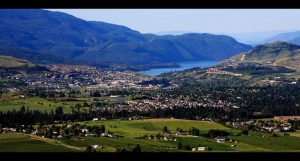Market Update – October 2021
OCTOBER 2 0 2 1 | V O L . 1
THE C21 EXECUTIVES
REPORT
T h e o f f i c i a l p u b l i c a t i o n o f t h e C e n t u r y 2 1 E x e c u t i v e s R e a l t y L t d .
O k a n a g a n S h u s w a p

WHEN IS THE BUBBLE GOING TO BURST?
W R I T T E N B Y B I L L H U B B A R D O W N E R | B R O K E R
The most common questions I get asked today are, "When is the bubble going to burst?" or "what's going to happen in the market?". In the last few stats reports, I mentioned that the stats tell me that the Real Estate Market in the Okanagan Shuswap is going to level off at a very strong market. That is what happened. How do I know that? First, I know that, unlike the stock market, the real estate market changes very slowly. The quickest we could see a complete turnaround in a market is about 6 months. Next, in order for that turnaround to start the inventory has to rise to a level where buyers have multiple choices to consider offering on ie: it becomes a buyer's market. A lot of Realtors don't even know what that is because they have yet to see one. Lastly, the absorption rate has to drop below 20%. It presently has levelled off to around 40 to 50%, depending on the zone in the Okanagan Shuswap.
INVENTORY
W R I T T E N B Y B I L L H U B B A R D
Every year, inventory starts to rise in the first quarter of the year. It peaks in the summer and begins to fall in the fall season to start the cycle over again in the winter; except this year. In all 3 zones the inventory has been flat as a pancake. To illustrate this point even more, compare the graphs for new listings to the inventory graphs. They illustrate that the new listings rose in the first quarter like they always do.
However, the inventory did not follow like it always does. What does this mean? It means that the demand still strongly outweighs the supply. People outside the Okanagan Shuswap are still trying their best to move here and buy or rent something.
I had a friend tell me that Robert Kiosaki is stating that the biggest market crash in history is coming to the stock market, gold, silver and bitcoins. I can tell you that I know nothing about these markets. I can also tell you that Robert Kiosaki's main goal is to sell books and seminars. Saying the markets will maintain doesn't do that very well. Catastrophe sells much better than steady as you go. It is interesting that Realtors who do not know how to follow and read statistics are predicting a crash in the Real Estate market. When I ask them why, many times they will quote data that has historically been very poor indicators of what is going on or they say, "I just feel it in my bones". There is a professional statement!
As far as the Okanagan Shuswap Real Estate market is concerned, in order for them to be right the inventory has to double and the absorption has to drop below 20%. That will change this extreme seller's market into a buyer's market. That may happen but it is going to take a while and right now there are no statistical indicators that predict that it is coming.

More Canadians Are Moving to BC Than Anywhere Else in the Country
W R I T T E N B Y S T O R E Y S E D I T O R I A L T E A M
With its stunning scenery, salt air, and distinct west coast vibe, the appeal of British Columbia (BC) is undeniable. Many fellow Canadians apparently agree. A new report from Statistics Canada,
released on September 29, shows that BC experienced the largest net gain in interprovincial migration in the 12-month period ending June 30, 2021. The province’s net interprovincial migration – the difference between residents moving into and out of a region – was +34,277 in 2020/21. This marks the largest migration increase in BC in 28 years.
On the other (more affordable) coast, Nova Scotia also experienced a net high migration (+9,949). Neighbouring New Brunswick also experienced a relatively high influx of new residents (+3,887) – some, who were perhaps swayed by the province’s compelling campaign to encourage Canadians to take advantage of the province’s low home prices. Meanwhile, Newfoundland and Labrador’s interprovincial migration rate at +785.
While BC was a hot spot on the relocation front, the province’s neighbours in the Prairies didn’t fare so well, with Alberta (-11,831), Manitoba (-9,685), and Saskatchewan (-9,410) reporting more residents moving out than in (and this was before things really started to go south in Alberta in the pandemic department too).
The pandemic appears to have inspired a re- evaluation of lifestyle and living space, as Canadians packed their bags and set their sights on new provinces like they haven’t in years. According to Stats Can, Canadians are relocating to other provinces at a rate we haven’t seen since the 90s. Naturally, this is fuelled by a remote work culture that has become the norm. According to Stats Can, Canada’s overall population is struggling to catch up to pre-pandemic numbers, which have been influenced by COVID-related deaths and restrictions on immigration. Not surprisingly, Canada’s
population growth took a major nosedive in response to the relentless pandemic, with its pace of growth estimated to be +0.5 percent. Marking the slowest growth rate since 1915/16 – during the grips of the First World War – this was less than half of its 2019/20 growth (+1.2%).
While BC may be an attractive option in the lifestyle front, calling the mountain-filled province home doesn’t come cheap — especially when it comes to real estate. After all, it’s no coincidence that Metro Vancouver is the eviction capital of Canada.
Not to put bad vibes out there. Here’s to hoping all of the province’s new residents are able to stay… and still save for a rainy day (or in BC’s case, many rainy days).

